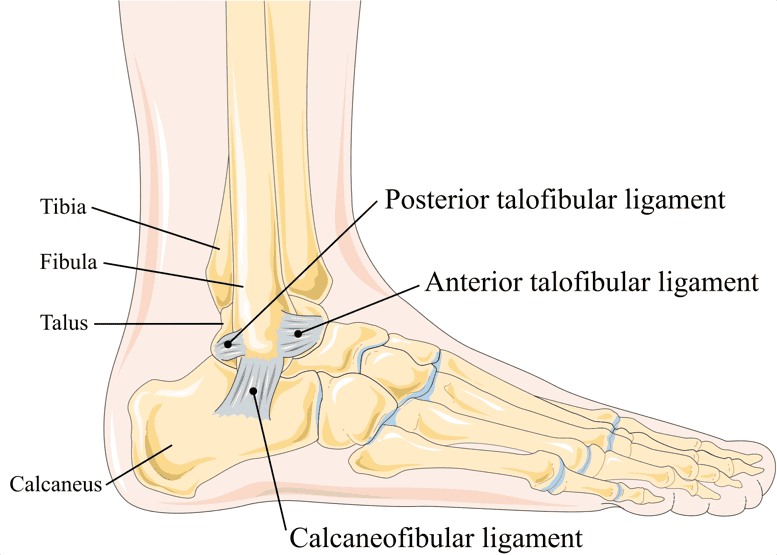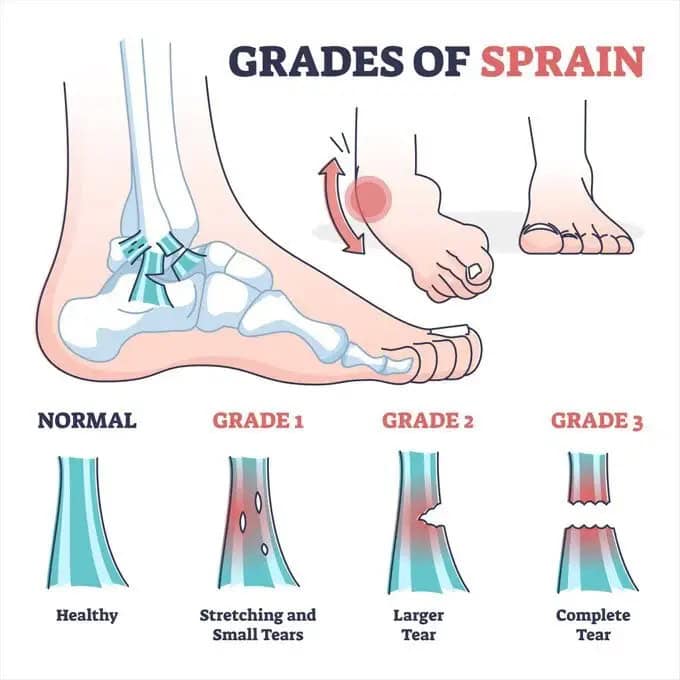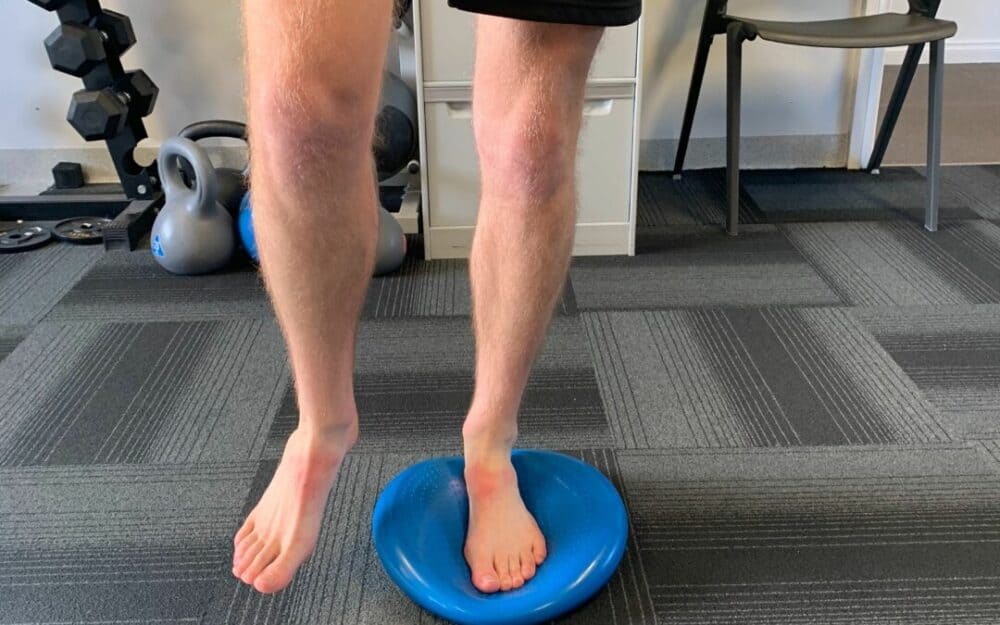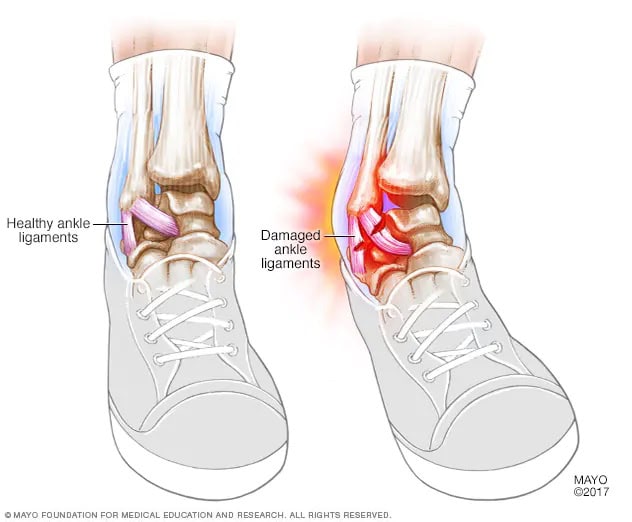What is an Ankle Sprain?
An ankle sprain occurs when the ligaments surrounding the ankle are stretched, partially or completely torn. Ligaments are tissue that attach from bone to bone and provide proprioceptive feedback to keep us up right and balanced when we are stationary or moving. Ligaments also help to keep our joints stable when we are moving them. For a ligament to be stretched, partially or completely torn, there typically needs to be an excessive force to the ankle and/or an awkward twist. There are a few different types of ankle sprains that typically occur:
- Lateral ankle sprain: This is the most common, often referred to as “rolling” your ankle.
This occurs with twisting your ankle inwards with an excessive force or even your body
weight. The ligaments affected are your anterior talofibular ligament, calcaneofibular
ligament, and posterior talofibular ligament.

- Medial ankle sprain: This is less common, however occurs when we twist our ankle outwards with an excessive force, which affects a group of ligaments on the inside of our ankle called the deltoid ligament.
- High ankle sprain: This typically occurs from rotational type injury, such as planting our ankle and rotating our leg at the same time. This affects a ligament a bit higher up on our ankle called our anterior inferior tibiofibular ligament.
Common Causes of Ankle Sprains:
- Landing on your foot awkwardly after jumping or pivoting
- Walking/running on uneven surfaces
- Slipping off a curb
- Another person stepping on your foot/ankle
- A fall that causes your ankle to twist
Symptoms of an Ankle Sprain:
- Pain in the ankle
- Increased pain with weight bearing or excessive activity on your feet
- Tenderness when touching the ankle
- Bruising
- Swelling
- Reduced ankle mobility
- Weakness surrounding the foot and ankle
- An instability feeling in the ankle with walking
What to do if you think you just sprained your ankle?
The initial stages after an ankle sprain are quite important. Prior to getting in to see your physiotherapist, there are a few things you can do to accelerate your healing and improve your prognosis. These can include icing your ankle with combined compression and elevation. Also, avoiding strenuous activity, such as walking, running or hiking. These simple, but important steps can go a long way in your recovery!
How is an Ankle Sprain Diagnosed?
An ankle sprain can be diagnosed by different health care practitioners, including a physiotherapist. The physiotherapist will begin by asking your questions about how you hurt your ankle, including the mechanism of injury, if you felt a popping sensation, if there was any bruising and/or swelling, and if you have had any previous ankle injuries. The physiotherapist will then carry on with an objective evaluation which may include a gait analysis, range of motion testing, strength testing, palpation and ligament stress testing. Depending on the grade of your sprain, it is important that the physiotherapist complete a comprehensive examination to rule out the potential for an ankle fracture. Rarely is imaging used to diagnose an ankle sprain, however if your health care practitioner is concerned, they may refer you for diagnostic imaging. If your physiotherapist diagnoses you with an ankle sprain, they will often communicate to you a grade of sprain.
For example:
- Grade 1 sprain: stretching or slight tearing of the ligament. You may have mild tenderness on palpation, swelling and ankle stiffness.
- Grade 2 sprain: increased stretching of the ligament but an incomplete tear. You may have moderate pain and swelling. Walking is likely painful, as well as the feeling of instability may occur.
- Grade 3 sprain: a complete tear of the affected ligament. You may have significant swelling and bruising. The ankle is unstable, and you are likely unable to walk due to pain.

How can a Physiotherapist help Treat an Ankle Sprain?
In treating an ankle sprain, it can be broken down into 3 continuous steps:
- Step 1: Reducing Pain and Inflammation: this may include strategies to help reduce the pain and inflammation such as icing, ultrasound, compression sleeves and acupuncture.
- Step 2: Restore mobility and begin strengthening: It is crucial to begin gentle pain free ankle range of motion as soon as possible. Your physiotherapist may help with mobilizing your ankle as much as you can tolerate, as well as prescribing you with exercises to begin moving it on your own. Also, when ready, you may be prescribed initial strengthening exercises for your ankle in non-weight bearing.
- Step 3: Return to sport and activity: In this stage, you will be walking pain free and progressing to more dynamic and proprioceptive exercises. Your physiotherapist may prescribe to specific exercises to mimic your sport. They may also recommend an ankle brace to wear to prevent another injury.

If you think you have suffered an ankle sprain, and are wanting to return to your favourite activity as fast as you can, call our clinic to book an appointment with one of our physiotherapists!

